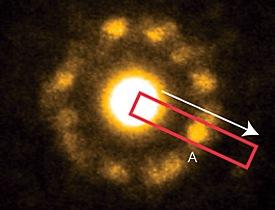

01/31/2011

From Ref. 1. © 2010 M.W. Chen
In contrast to most metals in which atoms are arranged in a repeated crystal pattern, the atoms in metallic glasses do not have long-range order. This gives them certain desirable characteristics, including resistance to wear and corrosion, and high strength. The continued improvement of metallic glasses would benefit greatly, however, from a detailed understanding of their atomic structure.
Various atomic models for metallic glasses exist, yet none have been confirmed because the experimental characterization of metallic glasses has been limited to the acquisition of average data over relatively large volumes. Now, in a collaboration between the WPI-AIMR and the Institute for Materials Research at Tohoku University, Osaka University in Japan and the Grenoble Institute of Technology in France, Mingwei Chen, Akihiko Hirata and colleagues have characterized the atomic structure of metallic glasses with unprecedented resolution by combining ‘nanobeam’ electron diffraction with molecular dynamics simulations1.
The researchers began by characterizing the metallic glass Zr66.7Ni33.3 using standard electron diffraction and electron microscopy tools. As expected, no diffraction spots were observed, indicating a lack of regular atomic order, and no order could be detected by electron microscopy. Unsatisfied with the finding, Chen, Hirata and their co-workers began work to make the electron beam narrower in order to resolve finer atomic structures. By correcting for spherical aberrations in their electron optics and using a specially designed electron beam condenser aperture, they were able to reduce the diameter of their electron beam to about three angstroms (Å) or 0.3 nanometers, the narrowest coherent electron beam demonstrated so far.
This much narrower beam produced a distinct set of diffraction spots (Fig. 1) that could only result from a single crystal, confirming predictions that metallic glasses are composed of small ordered atomic clusters as fundamental structural units, even though these materials are disordered on larger scales. By scanning their narrow beam around their sample and using a low-power beam to avoid damaging the atomic structure, the team was able to sample hundreds of ordered clusters, each about 4–7 Å in size. The data showed that the average atomic spacing inside an ordered atomic cluster was 2.4 Å. A molecular dynamics numerical model reproduced key features of the experimentally measured diffraction pattern, confirming that local order was indeed being observed.
According to Chen, this work could have consequences in both research and applications of metallic glasses. “We can now begin to propose a reliable atomic structure model for new metallic glass design, aiming for better forming ability and a better understanding of important physical processes such as glass transition and deformation,” he says.
Hirata, A., Guan, P., Fujita, T., Hirotsu, Y., Inoue, A., Yavari, A.R., Sakurai, T. & Chen, M.W. Direct observation of local atomic order in a metallic glass. Nature Materials 10, 28–33 (2011). | article
This research highlight has been approved by the authors of the original article and all information and data contained within has been provided by said authors.